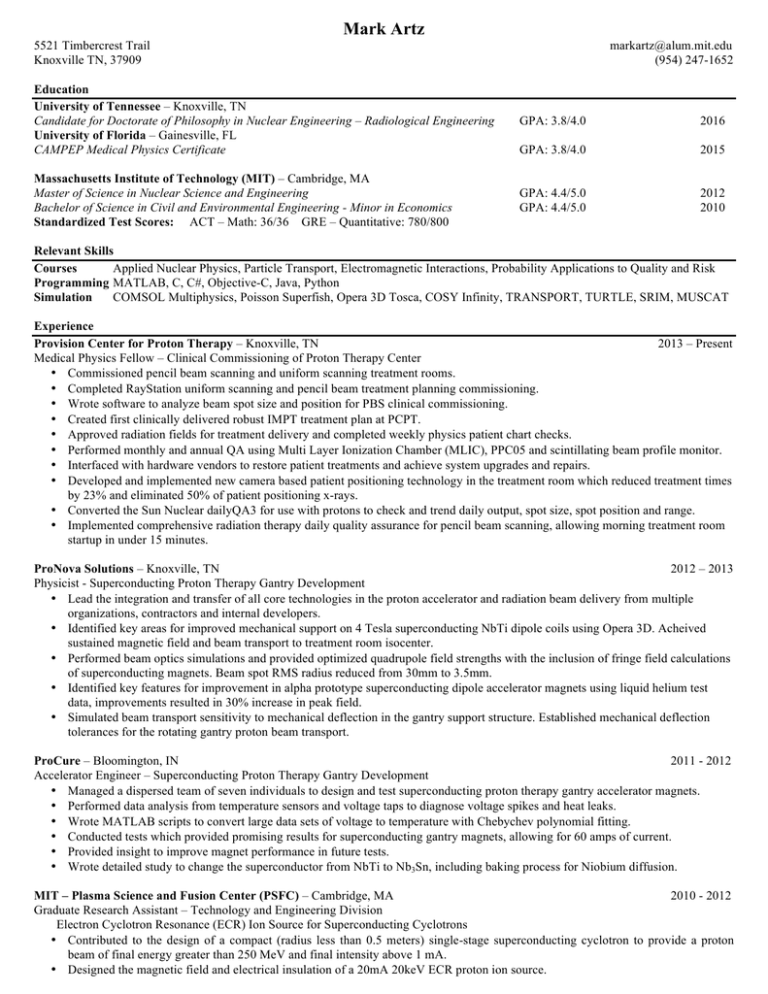Mark Artz`s Résumé
advertisement

Mark Artz 5521 Timbercrest Trail Knoxville TN, 37909 markartz@alum.mit.edu (954) 247-1652 Education University of Tennessee – Knoxville, TN Candidate for Doctorate of Philosophy in Nuclear Engineering – Radiological Engineering University of Florida – Gainesville, FL CAMPEP Medical Physics Certificate GPA: 3.8/4.0 2016 GPA: 3.8/4.0 2015 Massachusetts Institute of Technology (MIT) – Cambridge, MA Master of Science in Nuclear Science and Engineering Bachelor of Science in Civil and Environmental Engineering - Minor in Economics Standardized Test Scores: ACT – Math: 36/36 GRE – Quantitative: 780/800 GPA: 4.4/5.0 GPA: 4.4/5.0 2012 2010 Relevant Skills Courses Applied Nuclear Physics, Particle Transport, Electromagnetic Interactions, Probability Applications to Quality and Risk Programming MATLAB, C, C#, Objective-C, Java, Python Simulation COMSOL Multiphysics, Poisson Superfish, Opera 3D Tosca, COSY Infinity, TRANSPORT, TURTLE, SRIM, MUSCAT Experience Provision Center for Proton Therapy – Knoxville, TN 2013 – Present Medical Physics Fellow – Clinical Commissioning of Proton Therapy Center • Commissioned pencil beam scanning and uniform scanning treatment rooms. • Completed RayStation uniform scanning and pencil beam treatment planning commissioning. • Wrote software to analyze beam spot size and position for PBS clinical commissioning. • Created first clinically delivered robust IMPT treatment plan at PCPT. • Approved radiation fields for treatment delivery and completed weekly physics patient chart checks. • Performed monthly and annual QA using Multi Layer Ionization Chamber (MLIC), PPC05 and scintillating beam profile monitor. • Interfaced with hardware vendors to restore patient treatments and achieve system upgrades and repairs. • Developed and implemented new camera based patient positioning technology in the treatment room which reduced treatment times by 23% and eliminated 50% of patient positioning x-rays. • Converted the Sun Nuclear dailyQA3 for use with protons to check and trend daily output, spot size, spot position and range. • Implemented comprehensive radiation therapy daily quality assurance for pencil beam scanning, allowing morning treatment room startup in under 15 minutes. ProNova Solutions – Knoxville, TN 2012 – 2013 Physicist - Superconducting Proton Therapy Gantry Development • Lead the integration and transfer of all core technologies in the proton accelerator and radiation beam delivery from multiple organizations, contractors and internal developers. • Identified key areas for improved mechanical support on 4 Tesla superconducting NbTi dipole coils using Opera 3D. Acheived sustained magnetic field and beam transport to treatment room isocenter. • Performed beam optics simulations and provided optimized quadrupole field strengths with the inclusion of fringe field calculations of superconducting magnets. Beam spot RMS radius reduced from 30mm to 3.5mm. • Identified key features for improvement in alpha prototype superconducting dipole accelerator magnets using liquid helium test data, improvements resulted in 30% increase in peak field. • Simulated beam transport sensitivity to mechanical deflection in the gantry support structure. Established mechanical deflection tolerances for the rotating gantry proton beam transport. ProCure – Bloomington, IN 2011 - 2012 Accelerator Engineer – Superconducting Proton Therapy Gantry Development • Managed a dispersed team of seven individuals to design and test superconducting proton therapy gantry accelerator magnets. • Performed data analysis from temperature sensors and voltage taps to diagnose voltage spikes and heat leaks. • Wrote MATLAB scripts to convert large data sets of voltage to temperature with Chebychev polynomial fitting. • Conducted tests which provided promising results for superconducting gantry magnets, allowing for 60 amps of current. • Provided insight to improve magnet performance in future tests. • Wrote detailed study to change the superconductor from NbTi to Nb3Sn, including baking process for Niobium diffusion. MIT – Plasma Science and Fusion Center (PSFC) – Cambridge, MA 2010 - 2012 Graduate Research Assistant – Technology and Engineering Division Electron Cyclotron Resonance (ECR) Ion Source for Superconducting Cyclotrons • Contributed to the design of a compact (radius less than 0.5 meters) single-stage superconducting cyclotron to provide a proton beam of final energy greater than 250 MeV and final intensity above 1 mA. • Designed the magnetic field and electrical insulation of a 20mA 20keV ECR proton ion source.


